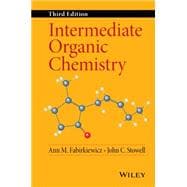
Ann Fabirkiewicz, PhD, is Professor of Chemistry at Randolph College where she teaches organic chemistry and biochemistry, including one on Intermediate Organic Chemistry.
John Stowell, PhD, was Professor of Chemistry at the University of New Orleans. His previous books include the first two editions of Intermediate Organic Chemistry and Carbanions in Organic Synthesis, published by Wiley.
Preface to the Third Edition xi
Preface to the Second Edition xiii
Preface to the First Edition xv
1 Reading Nomenclature 1
1.1 Acyclic Polyfunctional Molecules 2
1.2 Monocyclic Aliphatic Compounds 3
1.3 Bridged Polycyclic Structures 4
1.4 Fused Polycyclic Compounds 6
1.5 Spiro Compounds 10
1.6 Monocyclic Heterocyclic Compounds 12
1.7 Fused]Ring Heterocyclic Compounds 14
1.8 Bridged and Spiro Heterocyclic Compounds 19
Resources 20
Problems 21
References 22
2 Accessing Chemical Information 25
2.1 Databases 25
2.2 Chemical Literature 26
2.3 Synthetic Procedures 29
2.4 Health and Safety Information 30
Problems 32
References 33
3 Stereochemistry 35
3.1 Representations 35
3.2 Vocabulary 37
3.3 Property Differences Among Stereoisomers 40
3.4 Resolution of Enantiomers 44
3.5 Enantioselective Synthesis 47
3.6 Reactions at a Stereogenic Atom 49
3.6.1 Racemization 49
3.6.2 Epimerization 50
3.6.3 Inversion 51
3.6.4 Retention 51
3.6.5 Transfer 52
3.7 Relative and Absolute Configuration 53
3.8 Topism 56
Resources 59
Problems 60
References 65
4 Mechanisms and Predictions 69
4.1 Reaction Coordinate Diagrams and Mechanisms 69
4.2 The Hammond Postulate 71
4.3 Methods for Determining Mechanisms 72
4.3.1 Identification of Products and Intermediates 72
4.3.2 Isotope Tracing 73
4.3.3 Stereochemical Determination 74
4.3.4 Concentration Dependence of Kinetics 75
4.3.5 Isotope Effects in Kinetics 85
4.3.6 Temperature Effects on Kinetics 87
4.3.7 Substituent Effects on Kinetics 90
4.4 Representative Mechanisms 95
4.4.1 Reactions in Basic Solution 96
4.4.2 Reactions in Acidic Solution 100
4.4.3 Free]Radical Reactions 103
4.4.4 Molecular Rearrangements 106
Resources 108
Problems 109
References 120
5 Electron Delocalization, Aromatic Character, and Pericyclic Reactions 123
5.1 Molecular Orbitals 124
5.2 Aromatic Character 130
5.3 Pericyclic Reactions 135
5.3.1 Cycloaddition Reactions 137
5.3.2 Electrocyclic Reactions 142
5.3.3 Sigmatropic Reactions 147
Resources 152
Problems 152
References 158
6 Functional Group Transformations 163
6.1 Carboxylic Acids and Related Derivatives 164
6.1.1 Carboxylic Acids 164
6.1.2 Carboxylic Esters 166
6.1.3 Carboxylic Amides 168
6.1.4 Carboxylic Acid Halides 168
6.1.5 Carboxylic Anhydrides 169
6.1.6 Nitriles 169
6.1.7 O rtho Esters 170
6.2 Aldehydes, Ketones, and Derivatives 171
6.2.1 Aldehydes 171
6.2.2 Ketones 174
6.2.3 Imines and Enamines 175
6.2.4 Acetals 175
6.2.5 Vinyl Ethers 177
6.3 Alcohols 179
6.4 Ethers 179
6.5 Alkyl Halides 181
6.5.1 Alkyl Chlorides and Alkyl Bromides 182
6.5.2 Alkyl Iodides 184
6.5.3 Alkyl Fluorides 184
6.6 Amines 185
6.7 Isocyanates 187
6.8 Alkenes 187
6.9 Reductive Removal of Functionality 190
Resources 191
Problems 191
References 198
7 Carbon–Carbon Bond Formation 205
7.1 Carbon–Carbon Single Bond Formation 206
7.1.1 Reactions in Basic Solution 206
7.1.2 Reactions in Acidic Solution 214
7.1.3 O rganometallic Coupling Reactions 217
7.2 Carbon–Carbon Double]Bond Formation 218
7.3 Multibond Processes 222
Resources 224
Problems 224
References 230
8 Planning Multistep Syntheses 235
8.1 Retrosynthetic Analysis 235
8.2 Disconnection at a Functional Group or Branch Point 236
8.3 Cooperation for Difunctionality 244
8.4 Ring Closure 250
8.5 Acetylide Alkylation and Addition 253
8.6 T he Diels–Alder Reaction 255
8.7 T he Claisen Rearrangement 259
8.8 Synthetic Strategies 263
8.9 Final Note 265
Resources 266
Problems 266
References 271
9 Physical Influences on Reactions 277
9.1 Unimolecular Reactions 278
9.2 Homogenous Two]Component Reactions 279
9.3 Temperature Effects 280
9.4 Pressure Effects 281
9.5 Solvent Effects 282
9.6 Biphasic Reactions 283
9.6.1 Phase Transfer Catalysis 283
9.6.2 Increasing Solubility 286
9.6.3 Increasing Surface Area 287
9.6.4 Ultrasound 287
9.7 Reactions on Chemical Supports 288
9.8 Using Unfavorable Equilibria 291
9.9 Green Chemistry 293
Resources 294
Problems 294
References 295
10 Survey of Organic Spectroscopy 299
10.1 Electromagnetic Radiation 299
10.2 Ultraviolet Spectroscopy 300
10.2.1 Origin of the Signals 300
10.2.2 Interpretation 302
10.2.3 Visible Spectroscopy 302
10.3 Infrared Spectroscopy 303
10.3.1 Origin of the Signals 304
10.3.2 Interpretation 304
10.4 Mass Spectrometry 305
10.4.1 Origin of the Signals 306
10.4.2 Interpretation 307
10.5 N MR Spectroscopy 309
10.5.1 Origin of the Signals 309
10.5.2 Interpretation of Proton NMR Spectra 311
10.6 Carbon NMR Spectra 323
10.6.1 General Characteristics 323
10.6.2 Interpretation of 13C NMR Spectra 325
10.7 Correlation of 1H and 13C NMR Spectra 327
Resources 329
Problems 329
References 333
Appendix A 337
Appendix B 341
Index 347
The New copy of this book will include any supplemental materials advertised. Please check the title of the book to determine if it should include any access cards, study guides, lab manuals, CDs, etc.
The Used, Rental and eBook copies of this book are not guaranteed to include any supplemental materials. Typically, only the book itself is included. This is true even if the title states it includes any access cards, study guides, lab manuals, CDs, etc.